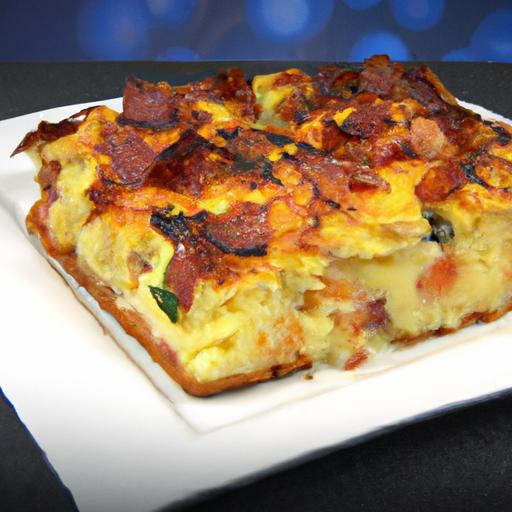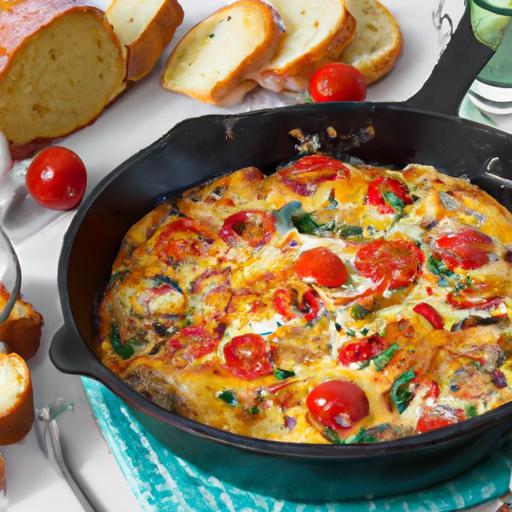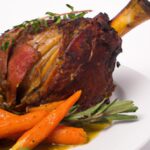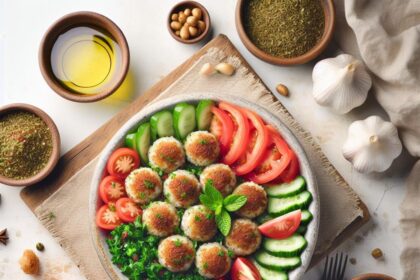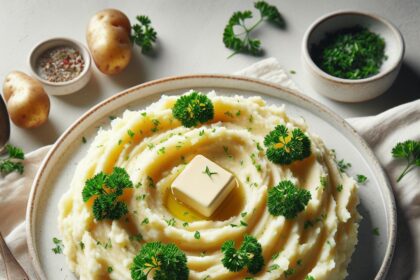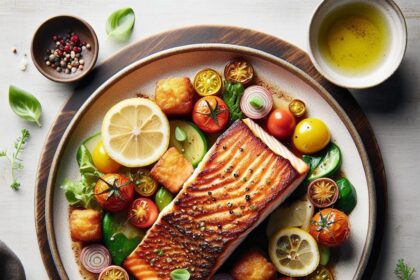When morning light spills over the kitchen counter, two savory heroes often steal the spotlight: the strata and the frittata. At first glance, these egg-based masterpieces might seem like close culinary cousins, both promising a hearty, flavorful start to the day. Yet beneath their golden crusts lies a world of subtle differences-different textures, ingredients, and histories-that set them apart and ignite a quiet breakfast rivalry. In this article, we’ll crack open the eggshell of tradition and technique to explore what makes a strata distinct from a frittata, uncovering the secrets behind each dish and why breakfast lovers around the globe can’t seem to choose between them. Whether you’re team strata or frittata, prepare to savor every delicious detail.
Strata vs. Frittata: Unpacking Breakfast’s Savory Rivalry invites you to explore two beloved egg dishes that turn simple ingredients into comforting morning masterpieces. Rooted in distinct culinary traditions, these dishes offer unique textures and flavors that make every bite an experience worth savoring. Whether you crave the layered richness of a strata or the rustic solidity of a frittata, understanding their origins, ingredients, and techniques empowers you to conquer the breakfast table with confidence and creativity.
Prep and Cook Time
- Prep Time: 20 minutes
- Cook Time: 40 minutes
- Total Time: 1 hour
Yield
Serves 6 hearty portions
Difficulty Level
Medium – Ideal for home cooks looking to level-up their brunch game
Ingredients for Classic Strata
- 8 cups cubed day-old bread (sourdough or country loaf preferred)
- 2 cups whole milk
- 8 large eggs
- 1 ½ cups shredded sharp cheddar cheese
- 1 cup cooked and crumbled breakfast sausage or bacon
- 1 medium onion, finely chopped
- 2 cloves garlic, minced
- 1 cup fresh baby spinach leaves, roughly chopped
- 1 tsp Dijon mustard
- ½ tsp salt
- ¼ tsp freshly ground black pepper
- Butter or non-stick spray for greasing
Ingredients for Classic Frittata
- 10 large eggs
- ¼ cup whole milk or cream
- 1 cup goat cheese, crumbled
- 1 cup sautéed mushrooms
- ½ cup sun-dried tomatoes, chopped
- 1 small red bell pepper, diced
- 2 tbsp fresh basil, chopped
- Salt and pepper to taste
- 2 tbsp olive oil
Instructions for Strata
- Preheat your oven to 350°F (175°C). Lightly grease a 9×13 inch baking dish with butter or non-stick spray.
- In a large bowl, whisk together eggs, milk, Dijon mustard, salt, and pepper until smooth and frothy.
- Layer the bread cubes evenly in the baking dish. Sprinkle the cooked sausage, sautéed onions, garlic, spinach, and shredded cheese between the layers of bread.
- Pour the egg mixture evenly over the strata. Press gently to allow absorption.
- Cover with foil and refrigerate for at least 1 hour or overnight for deeper flavor infusion and a luscious texture.
- Bake covered for 30 minutes, then uncover and bake another 10-15 minutes until the top is golden brown and eggs are fully set.
- Remove from oven, let rest for 5 minutes before slicing to serve.
Instructions for Frittata
- Preheat the oven to 375°F (190°C). Heat olive oil in an oven-safe skillet over medium heat.
- Add red bell pepper, mushrooms, and sun-dried tomatoes. Sauté until vegetables are tender and fragrant, about 5 minutes.
- Beat eggs, milk, salt, and pepper in a bowl until airy.
- Pour the egg mixture over the vegetables in the skillet. Lower heat to medium-low. Cook gently without stirring for 5-7 minutes, allowing edges to set.
- Sprinkle crumbled goat cheese and fresh basil evenly on top.
- Transfer the skillet to the oven and bake for 10-12 minutes or until the center is just firm and the top slightly golden.
- Remove from oven and let cool for 2-3 minutes before slicing directly from the skillet.
Chef’s Notes: Mastering Your Breakfast Showdown
- Texture Exploration: Strata’s layered custardy middle contrasts the frittata’s firm, tender crumb-choose according to your preferred bite.
- Bread Choice: Use sturdy, stale bread for the strata to avoid sogginess.
- Ingredient Swaps: For a vegetarian strata, omit meat and bulk up on veggies like zucchini or kale. Substitute goat cheese with feta or mozzarella in your frittata for creamier results.
- Make-Ahead Magic: Strata’s flavors deepen overnight-perfect for prepping the night before. Frittatas are best made fresh but reheat beautifully in a low oven.
- Pan Selection: Use a well-seasoned cast-iron or non-stick skillet for frittatas to ensure easy flipping and cleanup.
Serving Suggestions
Present your strata or frittata with a vibrant side of arugula salad dressed with lemon vinaigrette or a fresh tomato and avocado salsa. Garnish with sprigs of fresh herbs like basil, thyme, or chives to add a pop of color and aroma. Accompany with crispy breakfast potatoes or crusty artisan toast to round out the meal perfectly.

| Dish | Calories | Protein | Carbohydrates | Fat |
|---|---|---|---|---|
| Strata (per serving) | 320 kcal | 18 g | 30 g | 14 g |
| Frittata (per serving) | 280 kcal | 20 g | 8 g | 18 g |
Discover how these two dishes compare and complement one another by exploring our Ultimate Egg Recipes for Brunch. For an in-depth historical peek beyond the breakfast plate, visit Britannica’s Frittata Article.
Q&A
Q&A: Strata vs. Frittata – Unpacking Breakfast’s Savory Rivalry
Q1: What exactly are strata and frittata? Aren’t they just egg casseroles?
A1: It’s easy to lump strata and frittata together since both are savory, egg-based dishes, but they come from different culinary traditions and techniques. A strata is a layered casserole made with bread, eggs, cheese, and often vegetables or meat, assembled and then baked slowly. A frittata is more like an open-faced omelette – eggs whisked and mixed with fillings, then cooked gently on the stovetop or baked to finish. Think of strata as the baked sandwich of breakfast, and frittata as the elegant cousin who prefers the stove’s spotlight.
Q2: How does the preparation style set strata and frittata apart?
A2: Preparation is the heart of their difference. Strata requires a resting period where cubed bread soaks up the egg custard overnight-think of it as an overnight transformation. Frittata, on the other hand, is cooked almost immediately: eggs beaten and fillings folded in, then cooked slowly without fluffing or folding, typically finished in the oven or under a broiler. This gives frittata a dense, tender texture, while strata offers a rich, bread-laden bite.
Q3: Which one is better for feeding a crowd?
A3: Strata wins the crowd-pleaser award. Since it’s baked in a casserole dish, it can easily serve multiple guests and even be made ahead. It’s the ultimate make-ahead brunch hero. Frittatas can be sliced and shared but are usually cooked in smaller pans and demand immediate attention at the stove, making them ideal for smaller gatherings or more intimate brunches.
Q4: Are there flavor differences between the two?
A4: Absolutely! Strata’s bread base soaks up all the flavors-a savory custard infused with cheese, herbs, and the comforting chew of bread. It’s hearty and layered. Frittata showcases each ingredient boldly – chunks of vegetables, meats, or cheese suspended in creamy eggs, their textures and flavors standing out individually. Strata is a symphony; frittata is a spotlight solo.
Q5: Can strata and frittata be made gluten-free?
A5: Frittata naturally fits a gluten-free diet since it contains no bread. Strata, with its bread foundation, is traditionally not gluten-free unless you substitute gluten-free bread. So with the right loaf, strata can join the gluten-free party, but it requires a bit more intentionality.
Q6: Which breakfast champion should I try for a lazy weekend morning?
A6: For a leisurely, no-fuss morning, stratify your weekend with a strata! Prepare it the night before, then pop it in the oven while you sip your coffee. If you’re feeling spontaneous and love the sizzle of stovetop cooking, the frittata’s vibrant, immediate charm awaits. Either way, you’re scooping up savory satisfaction.
Q7: Any final tips for mastering these dishes?
A7: For strata, patience is your best friend-let that bread soak overnight to achieve custard perfection. For frittata, low and slow is key – cook gently to avoid rubbery eggs and finish under a broiler for a golden top. Both dishes beg for high-quality ingredients and love-infused seasoning.
Dive into this savory breakfast rivalry and find your champion – or better yet, enjoy the best of both worlds!
Final Thoughts
Whether you’re team strata or a frittata devotee, both dishes serve up a delicious testament to breakfast’s savory versatility. The strata’s layered, custardy comfort contrasts beautifully with the frittata’s open-faced, skillet-seared simplicity-each bringing its own story to the morning table. By unpacking their differences and shared qualities, we enrich not only our palates but also our appreciation for the culinary traditions that make breakfast such an indulgent ritual. So next time you face the age-old question-strata or frittata?-know that either choice leads to a hearty, flavorful start that celebrates eggs in all their creative glory.